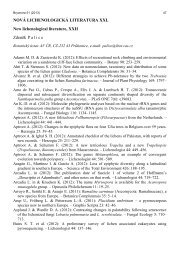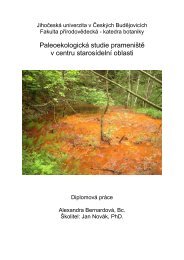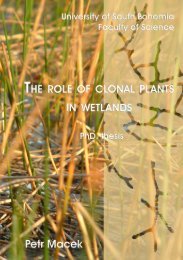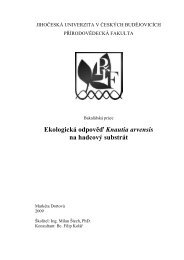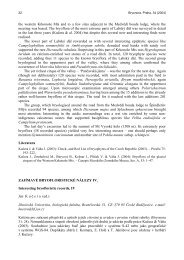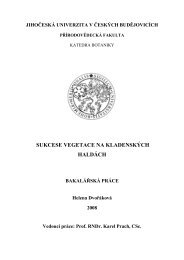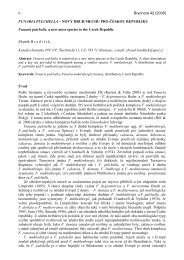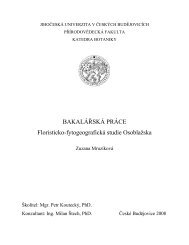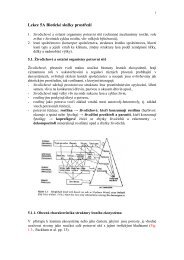Molecular phylogeny and taxonomic revision of chaetophoralean ...
Molecular phylogeny and taxonomic revision of chaetophoralean ...
Molecular phylogeny and taxonomic revision of chaetophoralean ...
Create successful ePaper yourself
Turn your PDF publications into a flip-book with our unique Google optimized e-Paper software.
Introduction 4<br />
unbranched taxa into a separate order, the Ulotrichales Borzi, but retained taxa with a<br />
branched thallus in the Chaetophorales. In 1982, the concept <strong>of</strong> the Chaetophorales was<br />
further refined by Silva, based on ultrastructural data. His circumscription included taxa<br />
(1) with filamentous, or rarely-parenchymatous thalli with uninucleate cells containing<br />
parietal chloroplasts with pyrenoid/s; (2) with ultrastructural features <strong>of</strong> the<br />
Chlorophyceae (presence <strong>of</strong> a phycoplast <strong>and</strong> a collapsing telophase spindle; cruciate<br />
flagellar roots with basal bodies which are more or less clockwise (CW) in<br />
displacement)); (3) with asexual (zoospores) <strong>and</strong>/or sexual (gametes/heterogametes)<br />
reproduction.<br />
As a result <strong>of</strong> the ultrastructural studies (summarized in Melkonian 1982, Mattox <strong>and</strong><br />
Stewart 1984) <strong>and</strong> later molecular phylogenetic analyses (e.g. Friedl <strong>and</strong> Zeltner 1994,<br />
Friedl 1995, Friedl 1996, Marin <strong>and</strong> Melkonian 1999, Sanchez-Puerta <strong>and</strong> Leonardi<br />
2006), many taxa <strong>of</strong> <strong>chaetophoralean</strong> algae (e.g. Chaetosphaeridium, Coleochaete,<br />
Klebsormidium, Leptosira, Microthamnion), traditionally restricted to the<br />
Chaetophorales, were re-classified into different orders or even different classes.<br />
Currently, the order Chaetophorales comprises an assemblage <strong>of</strong> (1) mainly-freshwater,<br />
rarely-terrestrial algae with a parenchymatous, or branched or unbranched filamentous<br />
thallus <strong>and</strong> with cells with parietal chloroplasts; (2) algae with a phycoplast associated<br />
with cell plate formation, with daughter cells kept interconnected by plasmodesmata,<br />
<strong>and</strong> with centrioles not involved in cell division (John 1984, Melkonian 1990). The<br />
order contains three families (Chaetophoraceae, Aphanochaetaceae <strong>and</strong><br />
Schizomeridaceae), <strong>and</strong> more than 20 described genera (for details see John 1984).<br />
However, until now, the number <strong>of</strong> molecular phylogenetic studies focusing on this<br />
order is surprisingly low. The first molecular study, based on nuclear-encoded SSU<br />
rDNA sequences included four taxa (Fritschiella, Chaetophora, Stigeoclonium,<br />
Uronema) <strong>of</strong> the Chaetophoraceae, <strong>and</strong> confirmed both the monophyly <strong>of</strong> this family<br />
<strong>and</strong> the position <strong>of</strong> the Chaetophorales within the Chlorophyceae (Booton et al. 1998).<br />
The addition <strong>of</strong> sequences from Aphanochaete <strong>and</strong> Schizomeris, to provide a ‘complete’<br />
order, increasing the sequences to include nuclear-encoded SSU + partial large subunit<br />
ribosomal DNA (LSU rDNA), led to the clear elucidation <strong>of</strong> the relationship between<br />
the Chaetophorales <strong>and</strong> the Chaetopeltidales (Buchheim et al. 2001). Recent<br />
phylogenetic analyses based on partial <strong>and</strong> complete chloroplast genomes <strong>of</strong> six<br />
members <strong>of</strong> the Chlorophyceae: Chlamydomonas reinhardtii, C. moewusii<br />
(Chlamydomonadales), Scenedesmus obliquus (Sphaeropleales), Oedogonium<br />
cardiacum (Oedogoniales), Stigeoclonium helveticum (Chaetophorales), <strong>and</strong> Floydiella<br />
terrestris (Chaetopeltidales) resulted in relationships among Chaetophorales,<br />
Chaetopeltidales <strong>and</strong> Oedogoniales (Brouard et al. 2008, Turmel et al. 2008, Turmel et<br />
al. 2009).



